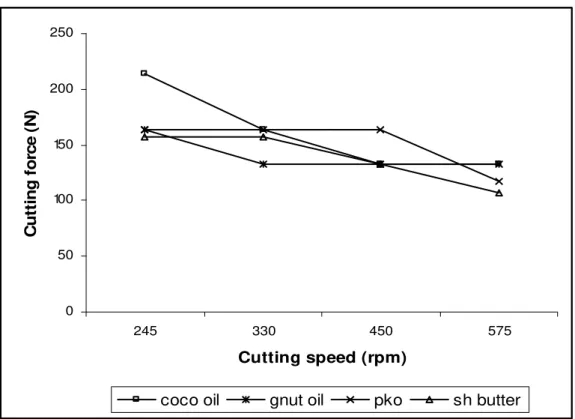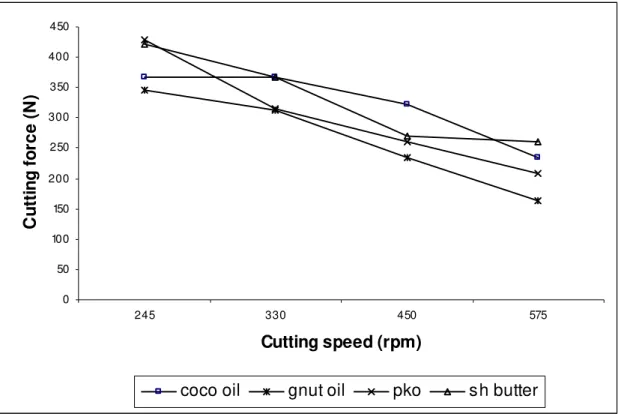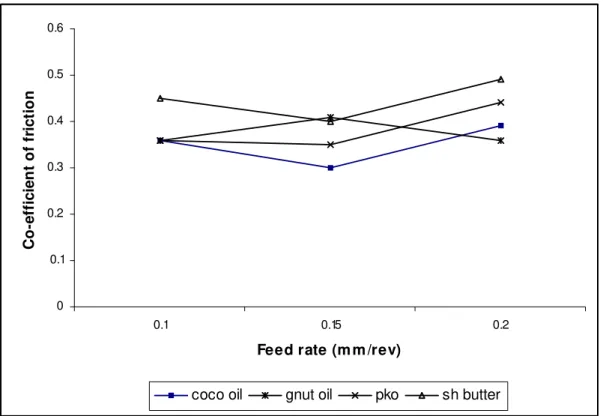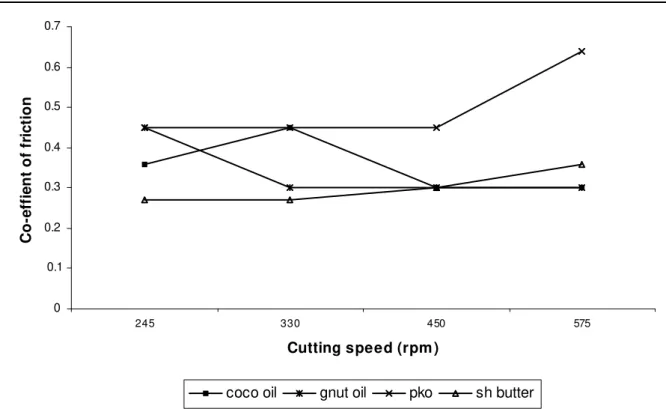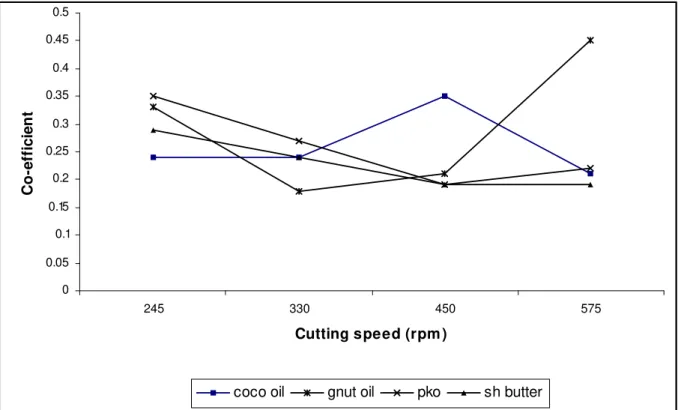ISSN 1 5 1 7 - 7 0 7 6
Revista Matéria, v. 13, n. 4, pp. 650 – 663, 2008 http://www.materia.coppe.ufrj.br/sarra/artigos/artigo11007
Autor Responsável: Ojolo, S.J Data de envio: 22/11/2007 Data de aceite: 21/06/2008
Experimental determination of the effect of some straight biological oils
on cutting force during cylindrical turning
Ojolo, S.J.I; Amuda, M.O.H.II; Ogunmola, O.Y.I; Ononiwu, C.U.I I
Department of Mechanical Engineering - University of Lagos, Lagos, Nigeria e-mail: ojolosunday@yahoo.com, bayemi@yahoo.com, cuononiwu@yahoo.com
II
Department of Metallurgical & Materials Engineering - University of Lagos, Lagos, Nigeria e-mail: mohrabiat2000@yahoo.com
ABSTRACT
Cutting fluids of various types are usually employed to control the heat generated in machining. The continued application of conventional petroleum based metal working fluids is being challenged by the need to reduce overall volume of fluids, minimize health risks and bio-contamination. Bio-oils assisted machining is an environmental bio-compatible technology for desirable control of temperature. This paper investigates the effect of some vegetable based oils on cutting force during cylindrical machining of mild steel, aluminium and copper.
The results indicated that bio oils are suitable for metal working fluids but the effects of the bio-oils on cutting force are material dependent. Groundnut oil exhibited the highest reduction in cutting force when aluminium was being turned at a speed of 8.25m/min and feeds of 0.10, 0.15 and 0.20mm/rev, respectively. Palm kernel oil had the best result when copper was turned at feeds lower than 0.15 mm/rev. However, at higher feeds, groundnut oil had the best result for copper. Coconut oil recorded the highest cutting force in all the three materials machined followed by shear butter and as such are very mild in reducing cutting force during cylindrical machining.
It is concluded that groundnut and palm kernel oils are effective in reducing cutting force during cylindrical turning. Though, the lubricating and cooling action is material dependent, groundnut oil is the best among the four bio-oils investigated.
Keywords: biological oils, cutting force, cylindrical turning.
1 INTRODUCTION
Machining is widely used in a variety of industries such as automotive, textile, aerospace and other manufacturing industries as a material finishing operation prior to actual deployment in service. In these industries, there are close restrictions on tolerance for proper fit of the component. In the recent past, there has been a greater demand for reducing the errors in machining operation. These errors arose primarily due to defect in the machine tool, cutters and the machining itself [1]. Of these, the error due to cutting force is one of the major problems for precision machining. The amount of cutting force applied during machining is dependent on the frictional characteristics of the machining process. In most machining processes, a great deal of frictional behavior is encountered, leading to the generation of high heat energy.
During a machining process, a substantial part of the energy is converted into heat energy through the friction generated between the tool and the work piece and the plastic deformation of the work material in the machining zone. The rapidly accumulated heat causes the temperature of the tool and workspace contact zone to rise at a fast rate, directly affecting the surface finish of the product. The resulting high temperature induces metallurgical transformation such as softening in the work piece. The transformation may lead to structural breakdown in the work piece and tool material (warping may result). This may adversely affect the quality of the machined products in terms of dimensional accuracy and surface finish. The heat generated during machining process is therefore critical in terms of product quality. It is therefore imperative that effective control of heat generated in the cutting zone during metal removal is crucial to ensuring good work piece surface quality [2].
651 various variables of tool geometry, radial rake angle is one of the most importants, which determines the tool and chip contact area and, hence, affects the power consumption.
Lubrication during machining offers great potentials in solving this problem. Lubrication not only reduces frictional force and enhance tool-life, it equally help cool the tool and work piece sufficiently and maintain them at ambient condition. This ensures that error of size resulting from thermal expansion is eliminated, metallurgical transformation is prevented and thus, dimensional accuracy and good surface finish is guaranteed. The reduction in frictional force brought about by lubrication leads to decrease in cutting force and ultimately reduction in manufacturing cost [3].
Cutting fluids have been used to deal with the problem of high heat generation and reduction of frictional force during machining operations. Cutting fluids are introduced in the machining zone to improve the tribological characteristics of the machining process and also to dissipate the heat generated. Several options of cutting fluids have been explored. Some of these are universal solvent, petroleum based metal cutting fluid and vegetable oil base metal cutting fluid. Conventional cutting fluids are essentially petroleum based, the continued application of which creates some techno-environmental problems, such as environmental pollution and biological problems to the operators [4].
Besides, the cutting fluids also incur a major portion of the total manufacturing cost [5]. These factors have combined to propel the need for prompt investigations into the use of bio-degradable coolants and lubricants.
Some researchers had investigated the possibility of using solid lubricants in machining process [6
-8]. The use of graphite as solid lubricant to reduce heat at the grinding zone has been investigated [8, 9]. The result of the experiment clearly indicated that the tangential force and surface roughness and normal force are higher compared to those in conventional grinding.
Equally, research on the possibility of replacing petroleum-based metal working fluids based on biological oils has become intense in recent years [10, 11]. Biological oil based metal working fluids sometimes refer to as vegetable oil based are plant-based products. They are cultivated and refined for specific performance properties and technical requirements. The successful application of bio-oils in metal cutting operation has been restricted to few percentages. Bio oils provide instrinsically strong and lubricious lubricating film and as such possess higher lubricating than conventional mineral oil metal working fluid. Biological oil cutting fluid has some superior features compared to the petroleum-based cutting fluids. These are reduced overall volume of fluids due to higher viscosity, minimized health risk to workers and minimized bio-contamination [12]. Skerlos & Hayes [13] studied canola, soybean and rape seed vegetable oil as cutting fluids. Their work demonstrated that in certain machining operations, the performance of vegetable based cutting fluids is comparable or better than the performance of the traditional petroleum based metal working fluids. The work has progressed so far enough that their current developed metal working fluids have been applied to a variety of manufacturing operations. Attempt is being made to pilot them soon in manufacturing environment.
During cylindrical turning operation, heat is generalized at both the primary deformation and secondary deformation zones. The temperature developed becomes maximum at the tool/chip interface. The heat is essentially generated from the frictional effect of the work piece on the cutting tool thereby leading to excessive cutting force with attendant increase in machining cost [14]. Machining forces are one of the important criteria by which the quality of any machining process is evaluated. In the published work of Bhattacharya [15], the relative contribution of different parameters on the cutting force was found to depend upon the type of work material, tool material and the presence of cutting fluid. The intensity of heat generation depends on this force and it is essentially significant as far as machining temperature and ultimately surface quality of the products are concerned.
The high temperature generated at the tool/chip interface invariably leads to softening of the work piece which may involve metallurgical transformation of the work piece. This affects the quality of turned work. There is need for controlling cutting zone temperature within permissible limit for achieving good machining performance. The application of conventional cutting fluid may not effectively guaranteed control of heat generated because it losses its cooling effect upon films boiling coupled with the fact that fluid boiling temperature of conventional fluid is lower than that of bio-degradable fluid. Hence, in this present work, four different agro-based oils-coconut oil, groundnut oil, palm kernel oil and shea butter oil, having higher viscosity relative to conventional cutting fluid, were used as metal cutting fluid and their effect on cutting forces on turning 3-different commonly machined metals at different feed rate and speed is evaluated.
652 2 MATERIALS AND METHODS
2.1 Materials & Experimental Set-up
The material requirement for the study are Hommel 600 lathe machine, a tungsten carbide cutter, four biological oils – groundnut oil, coconut oil, palm kernel oil and shear butter oil, mild steel, aluminium and copper metal rods of 30mm diameter and 100mm long. The experimental conditions are given in Table 1. The vegetable oils were obtained from Vegetable Oil Mill (VOM), Ojota, Lagos, Nigeria while the metallic alloys were obtained from Owode metal market, Lagos, Nigeria.
2.2 Test Procedure
Cutting forces were obtained during cylindrical machining of three different metallic rods-mild steel, aluminium and copper. The cutting variables considered were cutting speed, feed rate and depth of cut. The experiment was conducted using a Hommel 600 lathe machine as shown in Figure1.
The work pieces were firmly held in a 3-jaw chuck Hommel 600 lathe machine for orthogonal turning. The cutting tool (tungsten carbide) was mounted on the tool holder on the cuttin tool strain gage based dynamometer and fixed to the cross slide of the lathe. The graduated scales (the vertical and horizontal force meters) were zeroed as reference point and air resistance was assumed negligible.
Cylindrical turning operations were carried out on each 30mm diameter metal rods with each of the oils as cutting fluid at different cutting speeds, feed rate and depth of cut.
Varying spindle speeds of 250, 330, 450 and 550 rpm were investigated at a constant feed of 0.15mm/rev and 2mm depth of cut. The cutting speed in m/min is evaluated from the spindle speed by using equation 1[16]
4 rpm d
CS= × (1)
Where CS is the cutting speed in m/min, rpm is the spindle speed in rev/min and d is the tungsten carbide cutter diameter (see Table 1)
Varying feed rate was equally investigated at constant speed of 330 rpm and 2mm depth of cut. Thereafter, the depth of cut was varied (1.0, 1.5, 2.0 and 2.5mm) whilst the speed and feed rate were kept at 330rpm and 0.15/rev respectively.
At each situation of process variables-depth of cut, feed rate cutting speed and type of lubrication during the turning process - the horizontal (Fh) and vertical (Fv) components of the cutting forces were read from the strain gage based lathe dynamometer. The generated resultant cutting force is estimated from the relation
FR= ( )
2 2
v
h F
F + (2)
Where,
Fh = horizontal component of cutting force Fv = vertical component of cutting force
The coefficient of friction which is a measure of the frictional force is given by the equation
β
β
μ
tan tan
h v
v h
F F
F F
− +
653
Table 1: Experimental Conditions
Variable Conditions
Machine Tool Hommel 600 lathe machine
Cutter tool Tungsten carbide
Cutter diameter
10mm Overall length
78mm Tool geometry
Clearance angle
120 Side clearance angle
80 Approach angle
900 Plan angle
100 Side rake angle
50 Cutting conditions
Cutting speed- 6.25, 8.25, 11.25, 13.75m/min
Feed rate - 0.10, 0.15, 0.20mm/rev Depth of cut - 1.0, 1.5, 2.0, 2.5 mm Environment: wet metal cutting fluid - groundnut oil
- coconut oil - palm kernel oil - shear butter oil
Work pieces:Aluminium alloy Copper alloy
Mild steel
3 RESULTS
654
Figure 1a: Variation of cutting force with feed rate on aluminium at 2mm depth of cut using the four lubricants
0 50 100 150 200 250 300 350 400 450
0.1 0.15 0.2
Feed rate (mm/rev)
C
u
tti
n
g
fo
rc
e
(N
)
coco oil gnut oil pko sh butter
655 0
100 200 300 400 500 600
0.1 0.15 0.2
Feed rate (mm/rev)
C
u
tti
n
g
fo
rc
e
(N
)
coco oil gnut oil pko sh butter
Figure 1c: Variation of cutting force with feed rate on mild steel at 2mm depth of cut using the four lubricants
0 50 100 150 200 250
245 330 450 575
Cutting speed (rpm)
C
u
tti
n
g
fo
rc
e
(N
)
coco oil gnut oil pko sh butter
656
0 50 100 150 200 250 300 350 400 450
245 330 450 575
Cutting speed (rpm)
Cu
tt
in
g
f
o
rce
(N
)
coco oil
gnut oil
pko
sh butter
Figure 2b: Variation of cutting force with speed on copper at 2mm depth of cut using the four lubricants
0 50 100 150 200 250 300 350 400 450
245 330 450 575
Cutting speed (rpm )
C
u
tti
n
g
f
o
rc
e
(N
)
coco oil gnut oil pko sh butter
657 0
0.1 0.2 0.3 0.4 0.5 0.6
0.1 0.15 0.2
Feed rate (m m /rev)
C
o
-e
ff
ic
ie
n
t o
f
fr
ic
tio
n
coco oil gnut oil pko sh butter
Figure 3a: Variation of coefficient of friction with feed rate for aluminium at 2mm depth of cut using the four lubricants
0 0.1 0.2 0.3 0.4 0.5 0.6 0.7
0.1 0.15 0.2
Feed rate (mm/rev)
Co
-e
ff
ic
ie
n
t o
f f
ric
ti
o
n
coco oil
gnut oil
pko
sh butter
658 0
0.1 0.2 0.3 0.4 0.5 0.6
0.1 0.15 0.2
Feed rate (m m /rev)
Co
-e
ff
ic
ie
n
t o
f
fr
ic
ti
o
n
coco oil gnut oil pko sh butter
Figure 3c: Variation of coefficient of friction with feed rate for mild steel at 2mm depth of cut using the four lubricants
0 0.1 0.2 0.3 0.4 0.5 0.6 0.7
245 330 450 575
Cutting speed (rpm )
C
o
-e
ff
ie
nt of
f
ri
c
ti
on
coco oil gnut oil pko sh butter
659 0
0.05 0.1 0.15 0.2 0.25 0.3 0.35 0.4 0.45 0.5
245 330 450 575
Cutting speed (rpm )
C
o
-e
ff
icien
t
coco oil gnut oil pko sh butter
Figure 4b: Variation of coefficient of friction with feed rate for copper using the four lubricants
0 0.05 0.1 0.15
0.2 0.25 0.3 0.35 0.4 0.45 0.5
245 330 450 575
Cutting speed (rpm )
C
o
-e
ff
ici
e
n
t o
f f
rict
io
n
coco oil gnut oil pko sh butter
Figure 4c: Variation of coefficient of friction with cutting speed for mild steel using the four lubricants
4 DISCUSSION
660 is increased, more material will have to be cut per revolution, consequently more energy is required. This causes an increase in the cutting force. The Figure revealed that when aluminium was being turned, coconut and palm kernel oils had low initial cutting force of (put the value of the force here? ) at 0.1mm/rev feed rate. Whereas groundnut oil and shear butter display high cutting force of at this instance. Though the cutting force increases as the feed rate increases this was more pronounced in groundnut oil, coconut oil and shears butter at feed rate beyond 0.15mm/rev. With the use of palm kernel oil, however, the increase was more gradual than with the other three agro based oils. The comparative analysis of the four bio-oils when aluminum was being turned revealed that irrespective of the feed rate, groundnut oil as cutting fluid produced the least cutting force. This implies that the lubricity effect of groundnut oil is most efficient when aluminum is being turned.
In Figure 1b, when copper was being turned, the response of the cutting force to feed rate in the four bio-oils followed similar trend as was observed when aluminum was turned, except for the case of groundnut oil in which the cutting force tend to decrease as feed rate is increased beyond 0.15mm/rev.
The variation in cutting force with feed rate when mild steel was being turned is not discernible for the four oils at feed rate less than 0.15mm/rev (Figure 1c). At this instance, the variation appears equal irrespective of the lubricant used. However, beyond 0.15mm/rev the difference in the cutting force began to manifest. The apparent difference is not however very wide unlike in Figures 1a & b respectively.
Comparative analysis of the effect of the four bio oils on cutting force in the three turned materials revealed that the effect was more pronounced in the mild steel work piece compare to aluminum and copper. The implication of this is that, irrespective of the lubricant used, mild steel offers lower cutting force relative to aluminum or copper. It can be inferred that mild steel is likely to incur least cost compared with the other two work pieces.
Figure 2a-c show comparative illustration of the variations in cutting force with speed of cutting in different lubricating media for the three turned work pieces. Each curve of the graphs represents the response from each of the individual tested bio oils. A preliminary comparative analysis of the three work pieces revealed that all the four bio oils lead to decreases in cutting force as cutting speed increases in aluminum and copper but the opposite is the case in mild steel. Although, the reduction did not follow a general trend, the effect was most noticeable in Figure 2a where the least cutting force was achieved at around 105N at cutting speed of 14.38m/min using shea butter as metal working fluid. The trend of decrease in cutting force with increase in cutting speed should be expected because as cutting speed increases, machining becomes adiabatic and the heat generated in the shear zone can not be conducted away during the very short time in which the metal passes through this zone. The transient temperature rise softens the material aiding grain boundary dislocation and as such reducing cutting force as can be seen from Figures 2a and b. However, in Figure 2a shea butter was the most effective in reducing cutting force as speed increases while in Figure 2b, coconut oil was the most effective.
The very sharp sudden increase in cutting force as cutting speed increased between 8.25m/min and 11.25m/min as shown in Figure 2c can be explained in terms of the strain hardening tendency of mild steel. In the case of mild steel, unlike both aluminum and copper, the transient heat generated at the shear zone is not high enough to cause recrystallization of the dislocated grains; hence strain hardening result. The effect of strain hardening is to increase resistance to further plastic deformation which continuous chip removal represent; and as such, further chip removal is possible only at higher cutting force threshold. Beyond 11.25m/min, however, the heat generated is enough to cause recrystallization. This leads to softening of the work piece, therefore cutting subsequently maintain a steady value.
The graphical illustrations of the frictional curves resulting from the four bio oils in the three work pieces studied are presented in Figures 3a-c. Figure 3a revealed a progressive decrease in coefficient of friction as the feed rate is increased up to 1.5mm/rev for aluminum. There is a turning point at 0.15mm/rev, beyond which the coefficient of friction rises again. This is the pattern for three of the four considered bio oils – coconut, palm kernel and shear butter. However, unlike the other three oils, groundnut oil behaviour was completely opposite. That is, increasing in the early feed rate, reach a peak and then decreases at feed rate beyond 0.15mm/rev.
661 The situation that results when mild steel was turned is presented in Figure 3c. The figure revaled that groundnut and palm kernel oil are not desirable as metal working fluid when mild steel is being turned. These two fluids both had initial increase in coefficient of friction and later reduction beyond 0.15mm/rev feed rate. The reductions afterward were not compelling enough to recommend their use, coconut and shear butter had a better coefficient of friction but shear butter had the least irrespective of the feed rate. The figure revealed that when mild steel is being turned, shear butter is metal working fluid of choice. Figure 3c confirms the observation in Figures 3a and b that the performance of the bio oils is material dependent.
The higher the coefficient of friction, the higher the amount of energy required to initiate plastic deformation and shearing of the material. This therefore increases the cost of machining as machining force is increased. The requirement for machining therefore is to adopt metal working fluid that guarantee low-coefficient of friction. The low-coefficient of friction against cutting speed for the three work pieces in the four bio fluids are presented in Figures 4a-c. It is seen from the figures that the behaviour of the coefficient of friction versus cutting speed curves did not follow a particular pattern in all the working fluid investigated for all the work pieces. For instance, in Figure 4a, during the turning of aluminum, the behaviour of the four bio-oils did not reflect a predictable pattern. Apart from shear butter oil which had a coefficient of friction of around 0.28, the other three bio-oils coefficient of friction are sufficiently above 0.3. Though, groundnut oil and coconut oil tend to have a lower coefficient as cutting speed increases beyond 8.25m/min. Figure 4a revealed that palm kernel oil has the highest coefficient of friction among the four bio-oils irrespective of the cutting speed. The implication of this is that chips removal will require high cutting force thereby increasing the cost of machining. Therefore, when aluminum is being turned shea butter is not preferable rather palm kernel oil is.
The coefficient of friction against cutting speed when copper was turned is presented in Figure 4b. The Figure revealed that the coefficient of friction reduces as cutting speed increases when shear butter is used as metal working fluid. Though groundnut and palm kernel oils show initial decrease in coefficient of friction as cutting speed increases, the coefficient however increases sharply at cutting speed above 11.25m/min. Coconut oil was steady at 0.24 at cutting speed between 6.13m/min and 8.25m/min, beyond which it equally rises sharply before decreasing at cutting speed of 11.25m/min.
Figure 4c is the curve produced when mild steel was turned. From the graph, it is evident that shear butter had the least coefficient of friction of the four biological oils used. Coconut and groundnut oils were particularly poor recording a very high coefficient of friction greater than 0.40. The coefficient of friction recorded when mild steel was turned was the highest in all the three work pieces irrespective of the biological oils used. This is apparently due to the strain hardening tendency of the mild steel as explained. The strain hardening increase resistance to deformation and hence increases the coefficient of friction which translates to higher cutting force and ultimately higher machining cost. However, there is a phenomenon associated with turning operation known as built-up-edge (BUE), particularly in ferrous materials, which represents the attachment of portion of the chip to the tool face. It is reported [17] that the phenomenon becomes relevant at cutting speed ≤ 18m/min and progressively decreases afterwards and disappears at cutting speed ≥72m/min. The BUE effect is maximum at cutting speed of 18m/min. The effect of the presence of BUE is to produce unusual high friction stress and at the same time probably increase the rake angle. The unexpected increase in friction stress due to the presence of BUE effect increases the inertia to continuous chip formation and removal, hence higher cutting force. In the present investigation, the cutting speed range was between 6.25 and 13.75m/min; a range within the 18m/min cutting speed in which the BUE effect is relevant. Thus, it might be possibly explained that the increase observed in cutting force as cutting speed increases during mild steel turning in the current investigation is essentially due to the built-up edge (BUE) effect though the contributory influence of strain hardening could not be ruled out.
The highly lubricating properties of vegetable oils are made possible by the fundamental composition of the vegetable oil molecules as well as the chemical structure of oil itself. Lubricity of vegetable oils arises from the intrinsic oiliness of its constituents; and its properties are the direct result of the vegetable oil’s smart molecules. These molecules are long, heavy and dipolar in nature. The polar heads of the molecules have great chemical affinity for metal surfaces and attach themselves to the metal like magnets [9]. The result is a dense, homogenous alignment of vegetable oil molecules, perpendicular along the metal surface that creates a thick, strong and durable film layer of lubricant. This strong lubricating film gives the bio-oils a greater capacity to absorb pressure. The higher the molecular weight and flash point of the bio-oils the greater the lubricity. This apparently explains why groundnut oil presents itself as the best metal working fluid at varying depth of cut and constant speed in this study.
5 CONCLUSIONS
662 The study revealed that bio-oils are good materials as metal cutting fluids during machining and that their relative effects in improving product quality and reducing cutting force is material dependent. Groundnut oil exhibited the highest reduction in cutting force/coefficient of friction irrespective of the feed rates at cutting speed of 8.25m/min when aluminum was being turned. Palm kernel oil had the best result when copper was turned at feeds lower than 0.17mm/rev. However, coconut oil recorded the highest cutting force in all the three materials machined followed by palm kernel and as such are very weak in reducing cutting force and improving product quality. It is concluded that groundnut oil and shear butter are effective in reducing cutting force during cylindrical machining due to enhanced lubricating ability of the oils on account of their high molecular weights.
6 ACKNOWLEDGMENT
The authors manifest their gratefulness to the technical staff of the Machining Unit, Central Workshop, Faculty of Engineering, University of Lagos, Lagos, Nigeria for their material support and assistance in carrying out the turning operations of the current research work.
7 BIBLIOGRAPHY
[1] IOWA WASTE REDUCTION CENTRE. Cutting fluid management manual: a practical pollution
prevention guide, 3 ed., University of Northern Iowa, pp 1-61, 2003.
[2] KALPAKJIAN, S., SCHMID, S.R., Manufacturing engineering and technology, 4 ed., New Jersey, Prentice Hall, 2001.
[3] DINIZ, A.E., MICARONI, D.R., “Cutting conditions for finish turning process aiming the use of dry cutting’’, International Journal of Machine Tools Manufacture, v. 42, n. 8, pp. 889-904, 2002. [4] DE CHIFFRE, L., “Function of cutting fluid in machining”, Lubrication Engineering, v. 44, n. 6. pp.
514-518, 1988.
[5] BYERS, P., Metal working fluid, 3 ed. New York, Marcee Dekker Inc., 1994.
[6] SREEJITH, P.S., NGOI, B.K.A., “Dry machining: machining of the future”, Journal of Materials
Processing Technology, v. 101, n.1, pp 287-291, April 2000.
[7] KUMAR, N.S., RAO, R.P.V., “Experimental investigation to study the effect of solid lubricants on cutting forces and surface quality in end milling”, International Journal of Machine Tools &
Manufacture, v. 46, n. 2, pp. 189-198, 2006.
[8] GOPAL, A.V., RAO, P.V., “Performance improvement of grinding SiC using graphite”, Materials and
Manufacturing Process, v. 19, n. 2, pp. 177-186, 2004.
[9] SHAJI, S., RADHAKRISHMAN, V., “An investigation on solid lubricant moulded grinding wheels”,
International Journal of Machine Tools and Manufacture, v. 43, n.9, pp 965-972, July 2003.
[10] KRAHENBUHL, U., Cutting fluid: vegetable oil based coolants improve cutting performance, Tooling and Production, Blaser Swisslube Inc. Ohio, 2007.
[11] CLAYTON, B., Vegetable-Based Cutting Fluid. http://www.enjin.umich.edu/alumnite. Accessed in July 2007.
[12] ONONIWU, C.U., Effect of lubricants (local oils) on cutting forces during cylindrical turning, B.Sc. Thesis, University of Lagos, Lagos, 2005.
[13] SKERLOS, S., HAYES, K., Vegetable Based Cutting Fluid. A New Dimension in Research.
663 [14] SALLES, J.L.C., GONÇALVES, M.T.T., “Effects of machining parameters on surface quality of the
ultra high molecular weight polyethylene”,revista Matéria, v. 8, n. 1, pp 1-10, 2003.
[15] BHATTACHARYA, A., Metal cutting theory and practice, 2 ed. Calcutta, Central Book Publishers, 1984.
[16] MACHINE SHOP 3, Cutting speed and rpm calculations,

